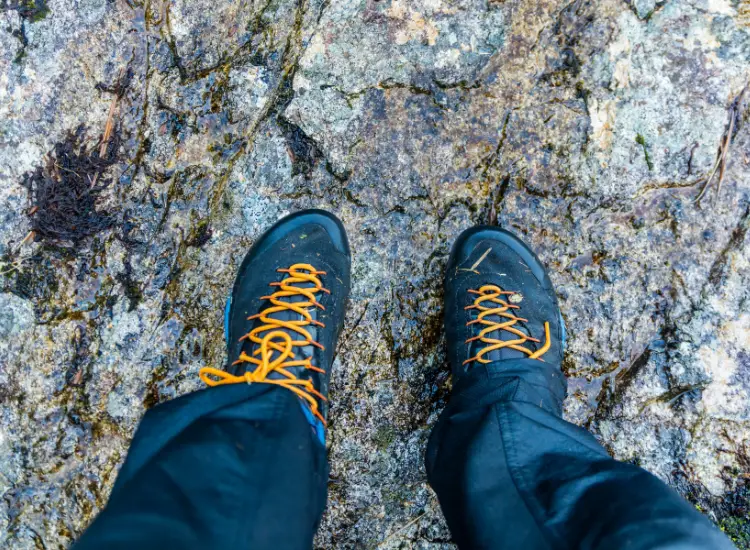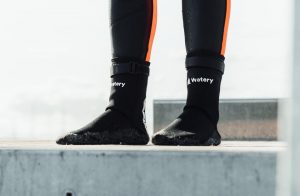What Are Approach Shoes? The Ultimate Guide

Approach shoes are a must-have for any serious outdoor adventurer. But what exactly are approach shoes? Well, they’re a type of footwear that’s designed to provide the perfect balance between hiking boots and climbing shoes. They’re meant to be worn during approaches to climbing routes where you’ll encounter a mix of hiking trails, rocky terrain, and technical scrambling.
So why do you need approach shoes? The answer is simple – they offer superior traction, stability, and protection compared to regular hiking shoes. With their sticky rubber soles and supportive construction, approach shoes allow you to confidently navigate tricky terrains, scramble over rocks, and even climb short sections of low-grade rock. Whether you’re heading out for a day of climbing or simply tackling a challenging hiking trail, approach shoes are a game-changer.
Quick Links
What are Approach Shoes?
Approach shoes are a type of footwear that are specifically designed for hiking and climbing approaches. An approach is the trek or hike that leads climbers from the base of a mountain or cliff to the start of a climbing route.
These shoes are designed to provide the necessary support, comfort, and durability required for both the approach and the descent. Approach shoes are typically a hybrid between hiking shoes and climbing shoes, combining the best features of each to create a versatile and functional footwear option.
Benefits of Using Approach Shoes for Hiking
Improved Grip and Traction
Approach shoes are specifically designed with sticky rubber soles that provide excellent grip and traction on various terrains. Whether you’re hiking on rocky trails, scrambling over boulders, or navigating wet surfaces, approach shoes can help minimize the risk of slips and falls, allowing you to confidently tackle challenging terrain.
Enhanced Stability and Support
One of the key benefits of approach shoes is their sturdy construction, which provides enhanced stability and support for your feet and ankles. The shoes often feature reinforced toe caps and midsoles, offering protection against impact and allowing you to tackle uneven surfaces with confidence. This added stability and support can reduce the risk of injuries and improve your overall hiking experience.
Versatility and Comfort
Approach shoes are designed to be versatile, making them suitable for a wide range of hiking activities. Whether you’re doing short hikes, long-distance treks, or even rock climbing approaches, approach shoes can accommodate various outdoor pursuits. Additionally, these shoes are designed with comfort in mind, featuring cushioned midsoles, breathable uppers, and padded collars and tongues for a comfortable fit throughout your hike.
Durability and Protection
Hiking can be tough on footwear, but approach shoes are built to withstand the rigors of the trail. They are typically made with durable materials and reinforced areas to protect against abrasion and wear. This durability ensures that your approach shoes can handle the demands of hiking and provide long-lasting performance, allowing you to enjoy many adventures without worrying about frequent replacement.
Lightweight and Compact
When it comes to hiking, carrying heavy footwear can be a burden. Approach shoes are designed to be lightweight and compact, reducing the weight on your feet and making it easier to maneuver on the trail. Their compact size also makes them convenient for packing in your backpack or attaching to your harness during climbing approaches, ensuring that you have the right footwear without taking up too much space or adding unnecessary weight.
Features to Look for in Approach Shoes
When choosing approach shoes, it’s important to consider various features that can enhance your hiking or climbing experience. These specialized shoes are designed to provide traction, stability, and protection on rugged terrains. Here are some key features to look for in approach shoes:
- Sticky Rubber Outsoles: Look for shoes with sticky rubber outsoles that offer excellent grip on different surfaces, including rock and wet terrain.
- Durable Construction: Choose shoes made from durable materials, such as synthetic fabrics or leather, that can withstand abrasion and rugged conditions.
- Ankle Support: Consider shoes with ankle support, either through a higher collar or a design that wraps around the ankle, to provide stability on uneven terrain.
- Toe Protection: Look for shoes with rubber toe caps or reinforced areas to protect your toes from impacts and abrasions.
- Comfort and Fit: Ensure that the shoes fit properly and are comfortable for long hikes or climbs. Look for features like cushioning, breathable materials, and adjustable closures.
- Approach-Specific Design: Some approach shoes come with specific features like climbing zone or climbing rubber for added traction and performance during climbing sections.
- Water Resistance: Consider shoes with water-resistant or waterproof materials if you’ll be hiking in wet or rainy conditions.
- Weight: Take note of the weight of the shoes, as lighter options can provide increased agility and reduced fatigue.
- Proper Sizing: Ensure that you select the appropriate size for your feet to avoid discomfort or blisters during your outdoor adventures.
Considering these features will help you find the right approach shoes that suit your specific needs and provide the necessary performance and protection for your outdoor activities.
Differences Between Approach Shoes and Regular Hiking Shoes
Design and Purpose
Approach shoes are specifically designed for technical approaches to climbing routes. They feature sticky rubber soles for better grip on rocky terrain and a low-profile design for precise foot placement. Regular hiking shoes, on the other hand, are designed for general hiking and walking on various trails and terrains. They may have more cushioning and a sturdier build for comfort and support during long hikes.
Sole Construction
Approach shoes often have a flat or semi-flat sole, allowing climbers to feel the rock and maintain sensitivity. The soles are made of sticky rubber for excellent traction on rocks and steep surfaces. Regular hiking shoes usually have a more aggressive tread pattern for better grip on different surfaces, including dirt, mud, and loose rocks. The soles may also have added cushioning for shock absorption during long hikes.
Ankle Support
Approach shoes typically have a lower profile and offer less ankle support compared to regular hiking shoes. This is because climbers need more freedom of movement and flexibility for technical maneuvers while ascending or descending rocky terrain. Regular hiking shoes are designed with higher ankle collars to provide additional support and stability during general hiking activities, which may involve uneven terrain or backpacking.
Weight
Approach shoes tend to be lighter in weight compared to regular hiking shoes. The focus is on a lightweight design to minimize energy expenditure during climbing approaches. Regular hiking shoes may have additional features such as extra padding, reinforced toes, and ankle support, which may contribute to a slightly heavier weight. The weight difference may not be significant, but it can make a difference for climbers who have to carry their gear on long approaches.
Overall Versatility
Approach shoes are highly specialized and excel in technical climbing approaches, where precision and grip are crucial. They may not perform as well on long hikes or on varied terrains. Regular hiking shoes, on the other hand, are more versatile and can handle a wide range of hiking conditions and trails. They offer better cushioning and support for longer hikes and generally perform well on different types of terrain.
Understanding the differences between approach shoes and regular hiking shoes can help you choose the right footwear for your specific outdoor activities. Consider the terrain, duration, and intensity of your adventures to determine which type of shoe is best suited for your needs.
How to Choose the Right Size and Fit for Approach Shoes
Choosing the right size and fit for approach shoes is crucial to ensure comfort, performance, and safety during outdoor activities. Ill-fitting shoes can lead to discomfort, blisters, or even accidents on rugged terrains. Here are some tips to help you select the perfect size and fit for your approach shoes:
- Measure your foot: Use a measuring tape or ruler to measure the length and width of your foot. This will help you determine your shoe size.
- Try them on: Visit a local outdoor store and try on different brands and models of approach shoes. Walk around and see how they feel on your feet.
- Consider foot shape: Look for approach shoes that match the shape of your feet. Some shoes are designed for narrow feet, while others are more suitable for wide feet.
- Leave enough toe room: Make sure there is about a thumb’s width of space between your longest toe and the front of the shoe. This will prevent your toes from hitting the front when descending or walking downhill.
- Check the heel fit: The heel should fit snugly without any slipping or rubbing. A secure heel fit is essential for stability and preventing blisters.
- Test the flex: Flex the shoe and see if it bends at the right points. The shoe should flex at the ball of the foot, matching your natural foot movement during approach or hiking.
- Consider sock thickness: If you plan to wear thick hiking socks, take that into account when choosing the shoe size. Try the shoes on with the socks you will typically wear during your outdoor activities.
- Ask for expert advice: Seek guidance from knowledgeable store staff or outdoor enthusiasts who can provide additional tips and insights on selecting the right size and fit.
By following these guidelines and taking the time to find the perfect size and fit, you can ensure optimal comfort and performance in your approach shoes, allowing you to fully enjoy your outdoor adventures.
Do Approach Shoes Require Breaking In?
Approach shoes are designed to provide the necessary grip and stability for hiking on rugged terrain, rock scrambling, and approaching climbing routes. When purchasing a new pair of approach shoes, it is common for them to require a breaking-in period before they become fully comfortable and perform optimally.
This is due to the materials used, such as durable leather or synthetic uppers, which can initially feel stiff and require some time to mold to the shape of your feet.
Best Brands for Approach Shoes
1. La Sportiva
La Sportiva is a reputable brand known for its high-quality approach shoes. They offer a wide range of models designed for various outdoor activities, including hiking, climbing, and scrambling. La Sportiva approach shoes are known for their durability, traction, and comfort, making them a popular choice among outdoor enthusiasts. View La Sportiva approach shoes.
2. Scarpa
Scarpa is another well-established brand that produces excellent approach shoes. With a focus on performance and innovation, Scarpa offers a range of models suitable for different terrains and activities. Their approach shoes are known for their precise fit, sticky rubber soles, and overall reliability. View Scarpa approach shoes.
3. Five Ten
Five Ten is a brand renowned for its grip and traction. Their approach shoes are favored by climbers and hikers for their sticky rubber outsoles, which provide excellent adherence to various surfaces. Five Ten approach shoes are known for their durability and performance even in challenging conditions. View Five Ten approach shoes.
4. Salomon
Salomon is a well-respected brand that offers a wide range of outdoor footwear, including approach shoes. Known for their quality and versatility, Salomon approach shoes are designed to provide stability, protection, and comfort. They offer models suitable for both hiking and climbing, catering to different needs and preferences. View Salomon approach shoes.
5. Mammut
Mammut is a brand that combines durability, functionality, and style in their approach shoes. With a focus on performance in alpine environments, Mammut offers a range of models with features like high-traction soles, precise fit, and waterproofing. Their approach shoes are designed to withstand rugged terrains and adverse weather conditions. View Mammut approach shoes.
When choosing approach shoes, consider factors such as fit, durability, traction, and the specific activities you plan to engage in. It’s always a good idea to try on different brands and models to find the perfect pair that suits your needs and preferences.
Maintaining and Cleaning Approach Shoes
To keep your approach shoes in good condition and ensure their longevity, proper maintenance and cleaning are necessary. Follow these tips to take care of your approach shoes:
- Regularly clean off dirt and debris: After each use, wipe off any dirt or mud from the shoes using a soft brush or cloth. This prevents build-up and keeps the shoes looking their best.
- Avoid soaking or machine washing: Approach shoes are made of specialized materials that may not withstand heavy soaking or machine washing. Instead, spot clean any stains or gently hand wash in lukewarm water using a mild detergent.
- Air dry after cleaning: After cleaning, allow the shoes to air dry naturally. Avoid using direct heat sources such as heaters or sunlight, as this can damage the materials.
- Treat leather uppers: If your approach shoes have leather uppers, periodically treat them with a leather conditioner to keep them supple and prevent cracking or drying out.
- Replace worn-out insoles: Over time, the insoles of your approach shoes may become worn or lose their cushioning. Consider replacing them with new insoles for optimal comfort and support.
- Store in a cool, dry place: When not in use, store your approach shoes in a cool, dry area to prevent mildew or damage. Avoid extreme temperatures or exposure to direct sunlight.
- Inspect for any damage: Regularly inspect your shoes for any signs of damage, such as worn-out outsoles, loose stitching, or delamination. Address any issues promptly to prevent further damage.
- Follow manufacturer’s care instructions: Always refer to the care instructions provided by the manufacturer for your specific pair of approach shoes. They may have additional recommendations or specific cleaning instructions.
By following these maintenance and cleaning tips, you can keep your approach shoes in good condition and ensure their performance and durability for your outdoor adventures.
Conclusion
Approach shoes are a versatile footwear option that provides the necessary support, grip, and durability for both hiking and climbing approaches. With their improved grip and traction, enhanced stability and support, versatility and comfort, durability and protection, and lightweight and compact design, approach shoes are an ideal choice for those looking to do a bit more than hiking.
By choosing the right pair of approach shoes, maintaining them properly, and considering your specific needs and preferences, you can enjoy comfortable and safe hiking and climbing approaches.







